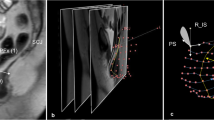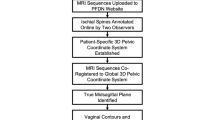Abstract
Introduction and Hypothesis
Our objective was to develop a standardized measurement system to evaluate structural support site failures among women with anterior vaginal wall-predominant prolapse according to increasing prolapse size using stress three-dimensional (3D) magnetic resonance imaging (MRI).
Methods
Ninety-one women with anterior vaginal wall-predominant prolapse and uterus in situ who had undergone research stress 3D MRI were included for analysis. The vaginal wall length and width, apex and paravaginal locations, urogenital hiatus diameter, and prolapse size were measured at maximal Valsalva on MRI. Subject measurements were compared to established measurements in 30 normal controls without prolapse using a standardized z-score measurement system. A z-score greater than 1.28, or the 90th percentile in controls, was considered abnormal. The frequency and severity of structural support site failure was analyzed based on tertiles of prolapse size.
Results
Substantial variability in support site failure pattern and severity was identified, even between women with the same stage and similar size prolapse. Overall, the most common failed support sites were straining hiatal diameter (91%) and paravaginal location (92%), followed by apical location (82%). Impairment severity z-score was highest for hiatal diameter (3.56) and lowest for vaginal width (1.40). An increase in impairment severity z-score was observed with increasing prolapse size among all support sites across all three prolapse size tertiles (p < 0.01 for all).
Conclusions
We identified substantial variation in support site failure patterns among women with different degrees of anterior vaginal wall prolapse using a novel standardized framework that quantifies the number, severity, and location of structural support site failures.




Similar content being viewed by others
References
Olsen AL, Smith VJ, Bergstrom JO, et al. Epidemiology of surgically managed pelvic organ prolapse and urinary incontinence. Obstet Gynecol. 1997;89(4):501–6. https://doi.org/10.1016/S0029-7844(97)00058-6.
Weber AM, Walters MD, Piedmonte MR, et al. Anterior colporrhaphy: A randomized trial of three surgical techniques. Am J Obstet Gynecol. 2001;185(6):1299–306. https://doi.org/10.1067/mob.2001.119081.
Nguyen JN, Burchette RJ. Outcome after anterior vaginal prolapse repair: A randomized controlled trial. Obstet Gynecol. 2008;111(4):891–8. https://doi.org/10.1097/AOG.0b013e31816a2489.
Shull BL, Bachofen C, Coates KW, et al. A transvaginal approach to repair of apical and other associated sites of pelvic organ prolapse with uterosacral ligaments. Am J Obstet Gynecol. 2000;183(6):1365–74. https://doi.org/10.1067/mob.2000.110910.
Lamblin G, Delorme E, Cosson M, et al. Cystocele and functional anatomy of the pelvic floor: review and update of the various theories. Int Urogynecol J. 2016;27(9):1297–305. https://doi.org/10.1007/s00192-015-2832-4.
Chen L, Lisse S, Larson K, et al. Structural Failure Sites in Anterior Vaginal Wall Prolapse: Identification of a Collinear Triad. Obstet Gynecol. 2016;128(4):853–62. https://doi.org/10.1097/AOG.0000000000001652.
Maher C, Kaven Baessler AE. Surgical management of anterior vaginal wall prolapse: an evidencebased literature review. Int Urogynecol J Pelvic Floor Dysfunct. 2006;7(2):195–201. https://doi.org/10.1007/s00192-005-1296-3.
Weber AM, Walters MD. Anterior vaginal prolapse: Review of anatomy and techniques of surgical repair. Obstet Gynecol. 1997;89(2):311–8. https://doi.org/10.1016/S0029-7844(96)00322-5.
Chen L, Swenson CW, Xie B, et al. A new 3D stress MRI measurement strategy to quantify surgical correction of prolapse in three support systems. Neurourol Urodyn. 2021;40:1989–98. https://doi.org/10.1002/nau.24781.
Bump RC, Mattiasson A, Brubaker LP, et al. The standardization of terminology of female pelvic organ prolapse and pelvic floor dysfunction. Am J Obstet Gynecol. 1996;175:10.
Trowbridge ER, Fultz NH, Divya PA, et al. Distribution of pelvic organ support measures in a population-based sample of middle-aged, community-dwelling African American and white women in southeastern Michigan. Am J Obstet Gynecol. 2008;198(5):548.e1–6. https://doi.org/10.1016/j.ajog.2008.01.054.
Larson KA, Luo J, Guire KE, et al. 3D analysis of cystoceles using magnetic resonance imaging assessing midline, paravaginal, and apical defects. Int Urogynecol J. 2012;23(3):285–93. https://doi.org/10.1007/s00192-011-1586-x.
Reiner CS, Williamson T, Winklehner T, et al. The 3D Pelvic Inclination Correction System (PICS): A universally applicable coordinate system for isovolumetric imaging measurements, tested in women with pelvic organ prolapse (POP). Comput Med Imaging Graph. 2017;59:28–37. https://doi.org/10.1016/j.compmedimag.2017.05.005.
DeLancey JOL. Fascial and muscular abnormalities in women with urethral hypermobility and anterior vaginal wall prolapse. Am J Obstet Gynecol. 2002;187(1):93–8. https://doi.org/10.1067/mob.2002.125733.
Chen L, Ashton-Miller JA, Delancey JOL. A 3D finite element model of anterior vaginal wall support to evaluate mechanisms underlying cystocele formation. J Biomech. 2008;42:1371–7. https://doi.org/10.1016/j.jbiomech.2009.04.043.
Moalli PA, Bowen ST, Abramowitch SD, et al. Methods for the defining mechanisms of anterior vaginal wall descent (DEMAND) study. Int Urogynecol J. 2021;32:809–18. https://doi.org/10.1007/s00192-020-04511-1.
Delancey JOL. The hidden epidemic of pelvic floor dysfunction: Achievable goals for improved prevention and treatment. Am J Obstet Gynecol. 2005;192(5):1488–95. https://doi.org/10.1016/j.ajog.2005.02.028.
Bowen ST, Moalli PA, Abramowitch SD, et al. Defining mechanisms of recurrence following apical prolapse repair based on imaging criteria. Am J Obstet Gynecol. 2021;225(5):506.e1–506.e28. https://doi.org/10.1016/j.ajog.2021.05.041.
Chen L, Schmidt P, Delancey JO, et al. Analysis of long-term structural failure after native tissue prolapse surgery: a 3D stress MRI-based study. Int Urogynecol J. 2022;33(10):2761–72. https://doi.org/10.1007/s00192-021-04925-5.
Brincat CA, Larson KA, Fenner DE. Anterior vaginal wall prolapse: Assessment and treatment. Clin Obstet Gynecol. 2010;53(1):51–8. https://doi.org/10.1097/GRF.0b013e3181cf2c5f.
Coats E, Agur W, Smith P. When is concomitant vaginal hysterectomy performed during anterior colporrhaphy? A survey of current practice amongst gynaecologists. Int Urogynecol J. 2010;21:S158–9.
Foon R, Agur W, Kingsly A, et al. Traction on the cervix in theatre before anterior repair: does it tell us when to perform a concomitant hysterectomy? Eur J Obstet Gynecol Reprod Biol. 2012;160(2):205–9. https://doi.org/10.1016/j.ejogrb.2011.11.002.
O’sullivan OE, Matthews CA, O’reilly BA. Sacrocolpopexy: is there a consistent surgical technique? Int Urogynecol J. 2016;27:747–50. https://doi.org/10.1007/s00192-015-2880-9.
Van Ijsselmuiden MN, Kerkhof MH, Schellart RP, et al. Variation in the practice of laparoscopic sacrohysteropexy and laparoscopic sacrocolpopexy for the treatment of pelvic organ prolapse: a Dutch survey. Int Urogynecol J. 2015;26(5):757–64. https://doi.org/10.1007/s00192-014-2591-7.
Norton IH, Orringer DA, Golby AJ. Image-Guided Neurosurgical Planning. Intraoperative Imaging Image-Guided Ther. Published online 2014:507-517. https://doi.org/10.1007/978-1-4614-7657-3_37
Joskowicz L, Hazan EJ. Computer aided orthopaedic surgery: Incremental shift or paradigm change? Med Image Anal. 2016;33:84–90. https://doi.org/10.1016/J.MEDIA.2016.06.036.
Jolesz FA, Golby AJ, Orringer DA. Magnetic resonance image-guided neurosurgery. Intraoperative Imaging Image-Guided Ther. Published online 2014:451-463. https://doi.org/10.1007/978-1-4614-7657-3_32
Dietz HP. Ultrasound in the assessment of pelvic organ prolapse. Best Pract Res Clin Obstet Gynaecol. 2019;54:12–30. https://doi.org/10.1016/j.bpobgyn.2018.06.006.
Lensen EJM, Withagen MIJ, Kluivers KB, et al. Surgical treatment of pelvic organ prolapse: a historical review with emphasis on the anterior compartment. Int Urogynecol J. 2013;24(10):1593–602. https://doi.org/10.1007/s00192-013-2074-2.
Luo J, Chen L, Fenner DE, et al. A multi-compartment 3-D finite element model of rectocele and its interaction with cystocele. J Biomech. 2015;48(9):1580–6. https://doi.org/10.1016/j.jbiomech.2015.02.041.
Medina CA, Candiotti K, Takacs P. Wide genital hiatus is a risk factor for recurrence following anterior vaginal repair. Int J Gynaecol Obstet. 2008;101(2):184–7. https://doi.org/10.1016/j.ijgo.2007.11.008.
Lowder JL, Oliphant SS, Shepherd JP, et al. Genital hiatus size is associated with and predictive of apical vaginal support loss. Am J Obstet Gynecol. 2016;214(6):718.e1–8. https://doi.org/10.1016/j.ajog.2015.12.027.
Vaughan MH, Siddiqui NY, Newcomb LK, et al. Surgical alteration of genital hiatus size and anatomic failure after vaginal vault suspension. Obstet Gynecol. 2018;131(6):1137–44. https://doi.org/10.1097/AOG.0000000000002593.
Acknowledgements
The authors thank Sarah Block for assistance in preparing the manuscript.
Funding
Supported by National Institutes of Health (NIH) the Eunice Kennedy Shriver National Institute of Child Health and Human Development R01 HD094954, R01 HD038665 and ORWH grant P50 HD044406.
Author information
Authors and Affiliations
Contributions
CX Hong: Project development, data analysis, manuscript writing
L Nandikanti: Data collection
B Shrosbree: Data analysis
JO DeLancey: Project development, data analysis, manuscript writing
L Chen: Project development, data analysis, manuscript writing
Corresponding author
Ethics declarations
Conflict of interest
C.X.H. is an advisor/consultant for Cosm Medical, Toronto, ON, Canada. All other authors declare no conflicts of interest.
Additional information
Publisher’s note
Springer Nature remains neutral with regard to jurisdictional claims in published maps and institutional affiliations.
Study conducted in Ann Arbor, MI
Presentation
This study was accepted for oral presentation at the American Urogynecologic Society/International Urogynecology Association Joint Scientific Meeting, June 14-18 2022, Austin, TX
Rights and permissions
Springer Nature or its licensor (e.g. a society or other partner) holds exclusive rights to this article under a publishing agreement with the author(s) or other rightsholder(s); author self-archiving of the accepted manuscript version of this article is solely governed by the terms of such publishing agreement and applicable law.
About this article
Cite this article
Hong, C.X., Nandikanti, L., Shrosbree, B. et al. Variations in structural support site failure patterns by prolapse size on stress 3D MRI. Int Urogynecol J 34, 1923–1931 (2023). https://doi.org/10.1007/s00192-023-05482-9
Received:
Accepted:
Published:
Issue Date:
DOI: https://doi.org/10.1007/s00192-023-05482-9







